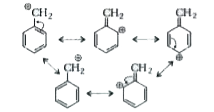Reaction of C6H5CH2Br with aqueous sodium hydroxide follows ………..Solution in Gujrati
SN1 mechanism
SN2 mechanism
Any of the above two depending upon the temperature of reaction.
Saytzeff rule
The correct Answer is:A
The presence of polar protic solvents such as H2O and formation of stable carbocation intermediate follows SN1 mechanism.

Topper's Solved these Questions
- BOOK - KUMAR PRAKASHANCHAPTER - HALOALKANES AND HALOARENESEXERCISE - SECTION - D NCERT EXEMPLAR SOLUTION (Short Answer Type Questions)35videos
HALOALKANES AND HALOARENES
- BOOK - KUMAR PRAKASHANCHAPTER - HALOALKANES AND HALOARENESEXERCISE - SECTION - D NCERT EXEMPLAR SOLUTION (Matching The Columns)6videos
HALOALKANES AND HALOARENES
- BOOK - KUMAR PRAKASHANCHAPTER - HALOALKANES AND HALOARENESEXERCISE - SECTION - C TEXTUAL EXERCISE87videos
HALOALKANES AND HALOARENES
- BOOK - KUMAR PRAKASHANCHAPTER - GENERAL PRINCIPLES AND PROCESSES OF ISOLATION OF ELEMENTSEXERCISE - SECTION - E (MCQs ASKED IN GUJET/BOARD EXAMS)46videos
GENERAL PRINCIPLES AND PROCESSES OF ISOLATION OF ELEMENTS
- BOOK - KUMAR PRAKASHANCHAPTER - POLYMERSEXERCISE - SECTION - E (MCQs asked in Board Exams)51videos
POLYMERS
Similar Questions
Aryl chloridesand bromides can be easily prepared by electrophilic substitution of arenes with chlorine and bromine respectively in the presence of Lewis acid catalysts. But why does preparation of aryl iodides requires presence of an oxidizing agent ?
07:06View SolutionMatch the compounds given in Column - I with the effects given in Column - II.
Column - IColumn - II(i)Chloramphenicol(a)Malaria(ii)Thyroxine(b)Anaesthetic(iii)Chloroquine(c)Typhoid fever(iv)Chloroform(d)Goiter(e)Blood substituent01:25View SolutionName the following halides according to IUPAC system and classify them as alkyl, allyl, benzyl (primary, secondary, tertiary), vinyl or aryl halides :
(CH3)2CHCH(Cl)CH303:23View SolutionDuring electrolysis of aqueous solution of Na2SO4 using graphite electrode .........
07:06View SolutionWhich polymer is used in preparation of capsules ?
04:49View SolutionPredict the order of reactivity of the following compounds in SN1 and SN2 reactions:
(i) The four isomeric bromobutanes
(ii) C6H5CH2Br,C6H5CH(C6H5)Br,C6H5CH(CH3)Br,C6H5C(CH3)(C6H5)Br06:42View SolutionReactions of C6H5CH2Br with aqueous sodium hydroxide follows:
07:06View SolutionThe correct order of reactivity of the compounds
(I) C6H5H2(Br), (II) C6H5CH(C6H5)Br, (III) C6H5CH(CH3)Br, (IV) C6H5C(CH3)(C6H5)Br in the increasing order of reactivity in SN2 reactions is04:33View SolutionS1N तथा S2N अभिक्रिया में निम्नलिखित यौगिकों की क्रियाशीलता का क्रम कारण सहित बताइए -
(i) ब्रोमोब्यूटेन के चार समावयवी
CH2−CH2−CH2C∣BRH2, CH3−C∣BrH−CH2−CH3, (CH3)2CH−C∣BrH2, (CH3)3C−Br
(ii)C6H5CH2Br, C6H5CH(C6H5)Br, C6H5CH(CH3)Br, C6H5C(CH3)C6H5BrView SolutionPredict the order of reactivity of the compounds in SN1 and SN2 reactions .
C6H5CH2Br,C6H5CH(C6H5)Br,C6H5CH(CH3)Br,C6H5C(CH3)(C6H5)Br03:21View SolutionThe decreasing order of reactivity of the following compounds in SN1 reactions is _________.
(i) C6H5CH2Br (ii)C6H5CH(C6H5Br
(iii)C6H5CH(CH3Br (iv)C6H5C(CH3)(C6H5)Br03:22View SolutionPredict the order of reactivity of the following compounds in S_(N)1 and S_(N)2 reactions: (i) the four isomeric bromobutanes (ii) C_(6)H_(5)CH_(2)Br,C_(6)H_(5)CH(C_(6)H_(5))Br,C_(6)H_(5)CH(CH_(3))Br,C_(6)H_(5)C(CH_(3))(C_(6)H_(5))Br .
04:55View SolutionReaction of C_(6)H_(5)CH_(2)Br with aqueous sodium hydroxide follows_______.
11:26View SolutionPredict the order of reacitivity of the following compounds in S_(N)1 and S_(N)2 reactions: (2) C_(6)H_(5)CH_(2)Br C_(6)H_(5)(CH_3)Br, C_(6)H_(5)C(CH_3)(C_(6)H_5)Br .
View SolutionReaction of C_(6)H_(5)CH_(2)Br with aqueous sodium hydroxide follows-
07:16View Solution

